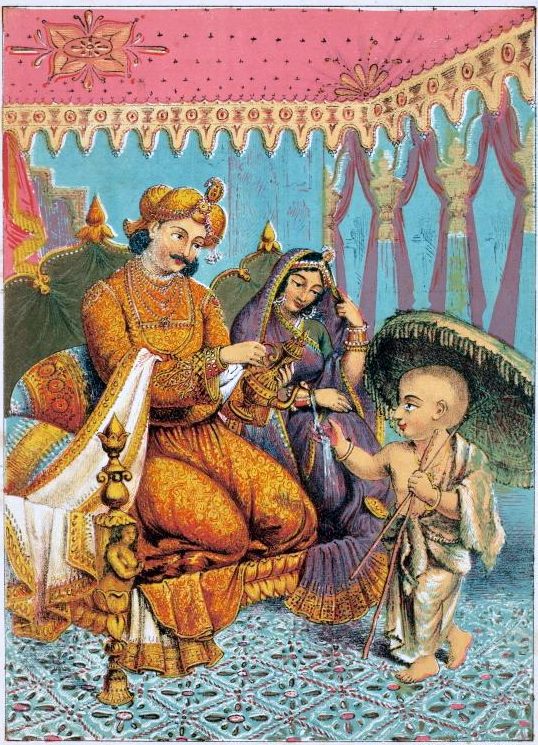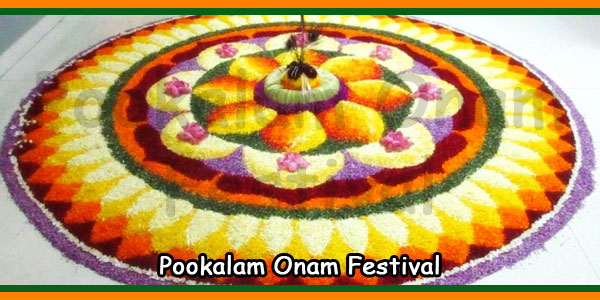All the Vaishnava saints called Azhvars were deeply in love with this incarnation. They enjoyed this avatar as can be seen by / in the pasurams sung by them. A few examples are given below:

Periazhvar:
Periazhvar had enjoyed the growth of Lord Krishna from his cradle to boyhood. He was the only Azhvar who sang to the Lord (Pallandu), while others sang in praise of him. In his Thirumozhi verses 44, 45 when he sings ‘lullaby’ to infant Krishna in the cradle the azhvars refers to Vamana avatar. In verse 104, while referring to the pranks of Lord Krishna the Azhvar refers to Vamana taking gigantic steps and swirling of Namveli, the son of King Mahabali.
ஓரடியும் சாடுதைத்த ஒண்மலர்ச் சேவடியும்,
ஈரடியும் காணலா மென்னெஞ்சே. - ஓரடியில்
தாயவனைக் கேசவனைத் தண்டுழாய் மாலைசேர்,
மாயவனையே மனத்து வை.
Oradiym sAdudhaiththa oN malarch chEvadiyum
Iradiyum kANalAm en nenjE Oradiyil
thAyavanaik kEsavanaith thaNduzhAy mAlai sEr
mAyavanaiyE manaththu vai
Word by Word Meaning
en nenjE – Oh my heart!
Oradiyil thAyavanai – one who measured all the worlds with one divine foot
kEsavanai – destroying a demon named kESi
thaN thuzhAy mAlai sEr – decorated with cool, thuLasi garland
mAyavanaiyE – only that emperumAn who has amazing activities
manaththu vai – keep in your heart
(if he is attained like this)
Or adiyum – the divine foot which measured the worlds
sAdu udhaiththa – kicked such that the wheel broke into smithereens
oN malar sEvadiyum – divine foot which is like a beautiful reddish flower
Iradiyum – both the divine feet
kANalAm – could see
Andal (Godha):
The maiden goes about inviting her friends to take bath in the early hours of the day (bath in the river of devotion to Sri Krishna). Her compendium of 30 songs could be divided into 3 stages of 10 verses each. In verses 3, 17 & 24 of Tiruppavai, she refers to Vamanan.
ஓங்கி உலகளந்த உத்தமன் பேர்பாடி
நாங்கள் நம்பாவைக்குச் சாற்றுநீ ராடினால்
தீங்கின்றி நாடெல்லாம் திங்கள் மும்மாரி பெய்து
ஓங்குபெரும் செந்நெல் ஊடு கயலுளக
பூங்குவளைப் போதில் பொறிவண்டு கண்படுப்பத்
தேங்காதே புக்கிருந்து சீர்த்த முலைபற்றி
வாங்கக் குடம்நிறைக்கும் வள்ளல் பெரும்பசுக்கள்
நீங்காத செல்வம் நிறைந்தேலோர் எம்பாவாய்(3)
அம்பரமே, தண்ணீரே, சோறே அறஞ்செய்யும்
எம்பெருமான்! நந்தகோ பாலா! எழுந்திராய்;
கொம்பனார்க் கெல்லாம் கொழுந்தே! குலவிளக்கே!
எம்பெரு மாட்டி! யசோதாய்! அறிவுறாய்;
அம்பரம் ஊடறுத் தோங்கி உலகளந்த
உம்பர்கோ மானே! உறங்காது எழுந்திராய்;
செம்பொற் கழலடிச் செல்வா! பலதேவா!
உம்பியும் நீயும் உறங்கேலோ ரெம்பாவாய். (17)
அன்று இவ்வுலகம் அளந்தாய்! அடிபோற்றி,
சென்றங்குத் தென்னிலங்கை செற்றாய்! திறல்போற்றி,
பொன்றச் சகடம் உதைத்தாய்! புகழ்போற்றி,
கன்று குணிலா எறிந்தாய்! கழல்போற்றி,
குன்று குடையா எடுத்தாய்! குணம்போற்றி,
வென்று பகைகெடுக்கும் நின்கையில் வேல்போற்றி,
என்றென்று உன்சேவகமே ஏத்திப் பறைகொள்வான்
இன்றுயாம் வந்தோம், இரங்கேலோ ரெம்பாவாய். (24)

Poigai Azhvar:
In his Mudal Tiruvandadhi, 21st verse he refers to the act of the Lord measuring 3 steps.
Bhoothathazhvar:
In his 5th verse of “Erandavdu Tiruvandadhi”, the reference is to the Lord’s act asking for 3 measures of Land. “Adi Moonril…”
அடிமூன்றி லிவ்வுலகம் அன்றளந்தாய் போலும்
அடிமூன் றிரந்தவனி கொண்டாய், - படிநின்ற
நீரோத மேனி நெடுமாலே நின்னடியை
ஆரோத வல்லார் அறிந்து.
Peyazhvar:
In “Moonram Tiruvandadhi” in 4th verse the azhvar refers to act of the Lord measuring with 3 steps.
மருந்தும் பொருளும் அமுதமும் தானே,
திருந்திய செங்கண்மா லாங்கே, - பொருந்தியும்
நின்றுலக முண்டுமிழ்ந்தும் நீரேற்றும் மூவடியால்,
அன்றுலகம் தாயோன் அடி. |
Nammazhvar:
In the azhvar’s “Periya Tiruvandadhi” in 16th verse, he refers to Vamana …. Per vamanan…agakall….In 51st verse the reference is both to Vamana and Krishna avatars in the same verse.
சீரால் பிறந்து சிறப்பால் வளராது,
பேர்வாம னாகாக்கால் பேராளா,-மார்பாரப்
புல்கிநீ யுண்டுமிழ்ந்த பூமிநீ ரேற்பரிதே?
சொல்லுநீ யாமறியச் சூழ்ந்து.
மனவாளும் μரைவர் வன்குறும்பர் தம்மை,
சினமாள்வித் தோரிடத்தே சேர்த்து-புனமேய
தண்டுழா யானடியே தான்காணும் அதன்றே,
வண்டுழாம் சீராக்கு மாண்பு?
|
Thirumangai:
His reference to Vamana avatar is abundant.

Decoding the Symbolisms of Lord Vamana
The demon king, Bali, was fair and righteous, yet for all his virtues, Bali was extremely proud and driven by fierce ambition. After conquering the Underworld and all the Earth, Bali managed to wrest the Heavens from the God Indra. Unable to reclaim his seat, Indra implored Vishnu for aid, and so Vishnu took the form of a small mortal man, a priest named Vamana.
In his splendid palace, Bali was giving gifts to the pious. Vishnu, took the form Vamana and carrying a wooden umbrella, requested only as much land as he could cover in three steps. Bali offered Vamana an island but Vamana stuck to his request, which Bali granted against the wishes of his advisor. Immediately, Vamana grew to cosmic proportions, crashing through the ceiling of the palace and filling the sky. With one colossal step, he engulfed all the Earth and the Underworld. With a second step, he consumed the heavens. Now, with everything under his two units, Vamana had nowhere to place his third step. He challenged Bali to go back on his word or offer somewhere else for him to step. Bali’s demon army surged forth, but the demon king held them back. Bowing in humility, Bali offered his head as the third step. Vamana sends Bali to the underworld but, in recognizing Bali’s benevolence, shows mercy by granting him sovereignty over it in appreciation of Bali’s sacrifice.
Vishnu returned control of the Heavens to Indra and left his Avatar behind, but he also left behind a valuable lesson. Even the mightiest and most arrogant of kings can be humbled by the smallest of men.
Decoding the Attha Pookolam:
Pookolam rangoli designs are usually created in ten rings, each ring representing deities in the Hindu pantheon.
First rings describes Lord Ganesha, second ring defines Shiva and Shakti, third-Lord Shiva, fourth-Lord Brahma, fifth dedicated to Pancha Boothangal, sixth-Shanmughan, seventh describes Guru, eighth – Ashta Digpalakar, ninth defines describes Indra and tenth defines Lord Vishnu
The size of a pookalam is increased daily for ten days, by adding a ring or a step on the outside to the initial pookalam design. On the main day of Onam, a really large pookolam gets ready.\
The making of a Pookolam is an events in itself, and is an extremely colourful and joyous one.

Decoding the Onam Sadya:
The dishes in a Sadhya are not served in a random order, but there is a particular sequence to this.
Talking about the most important dishes in a sadhya, native one adds, “We make something called the injicurry which is like a chutney of ginger and tamarind. Then there is thoran, kalan, avial and so on which are all vegetable based. Sambar, daal and papad is a must too.”
Serving sadhya is an art in itself, The narrow part of the leaf faces the left and the dishes are served and eaten in a particular order that also aids digestion. A pinch of salt and a banana are served first and then the rest, it finally ends with a payasam or sweet.
Onam platter
Salt
Banana
Papad
Sarkara Varatti (banana wafers).
Pickle (often a mango pickle is served)
Injicurry
Thoran (dry vegetable dish with coconut sprinkled on top)
Olan (dish with vegetables, black eyed beans in a mildly spiced coconut gravy)
Avial (a mixed vegetable dish)
Pulissery (Yogurt-based dish, like a raita)
Kichadi
Kalan (A dish with raw banana in a buttermilk gravy)
Koottucurry (Curry with vegetables and Bengal gram dal)
Rice
Daal
Sambar
Rasam and Moru











